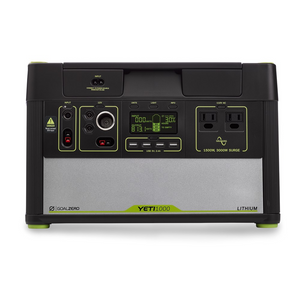 Highlights
Highlights  Video
Video  Use Cases
Use Cases  Recharging
Recharging  Reviews
Reviews 

Meet The Yeti 1000 Lithium Portable Power Station
YETI 1000 LITHIUM HIGHLIGHTS
- Instant power at the push of a button. Silent and powerful 1045Wh, 96.8Ah (10.8V) lithium battery.
- No more extension cords, no more gasoline, no more fumes with multi-stage patent pending 1500W AC inverter.
- Versatile powering options including: four USB ports, two AC outlets and 12V output.
- Informative display featuring a runtime/recharge time estimator, as well as a battery level monitor and an output/input meter.
WHAT CAN THE YETI 1000 LITHIUM POWER?
The Yeti 1000 Lithium is great for all your larger sized power needs or multiple smaller devices.
Smartphone: 50+ Recharges
POV Camera: 165+ Recharges
Headlamp: 165+ Recharges
Tablet: 37+ Recharges
Laptop: 17+ Recharges
Light-a-Life: 335+ Hours
Fridge: 17+ Hours
32 LCD TV: 10 hours
RECOMMENDED SOLAR PAIRINGS
- Light Usage Boulder 50: Charges in 31-62 Hours
- Standard Usage Boulder 100 Briefcase: Charges in 15-30 Hours
- Heavy Usage Boulder 200 Briefcase: Charges in 8-16 Hours
*Solar charge times vary and are dependent on many factors such as elevation, temperature, time of year, angle, and position to the sun.
THREE WAYS TO CHARGE THE YETI 1000 LITHIUM
- Recharge from the sun by connecting a compatible solar panel. Charge time is dependent on the size of the solar panel. The Boulder 200 Briefcase will fully recharge the Yeti 1000 Lithium in about 10-20 hours.
- Plug it into the wall. Fully recharges in 4 hours using the Yeti Fast Charge 25 Amp Power Supply or in 18 hours using included power supply.
- The Goal Zero Yeti 1000 Lithium can be charged in 9 - 18 hours by plugging into your vehicle's 12V outlet using the Goal Zero Yeti Lithium 12V Car Charging Cable. NOTE: Do not attempt to charge your Yeti Lithium from a 12V source using any other cable. Doing so may cause damage to the unit.
WHAT'S IN THE BOX
- Yeti 1000 Lithium Power Station
- Wall Charger
CHARGE TIMES
- Wall Charger (5A): 18 Hours
- Nomad 50: 31-62 Hours
- Boulder 50: 31-62 Hours
- Boulder 100: 15-30 Hours
- Boulder 100 Briefcase: 15-30 Hours
- Nomad 100: 15-30 Hours
- Boulder 200 Briefcase: 8-16 Hours
- Boulder 100 x 3: 5-10 Hours
- Boulder 200 Briefcase x 2: 4-8 Hours
- Boulder 200 Briefcase x 3: 3-6 Hours
GENERAL
- Product SKU: 38004
- Chainable: No
- Weight: 40 lbs (18.1 kg)
- Dimensions: 10.1 x 15.3 x 9.3 in (25.7 x 38.9 x 23.6 cm)
- Operating Usage Temp: 32-104 F (0-40 C)
- Warranty: 24 Months
PORTS
- USB Port (output): 5V, up to 2.4A (12W max), regulated
- 6mm Port (output): 12V, up to 10A (120 W max)
- 12V car port (output): 12V, up to 10A (120W max)
- 12V High Power Port (output): 12V, up to 10A (120W max)
- AC inverter (output, pure sine wave): 120VAC 60Hz, 12.5A (1500W, 3000W surge)
- Charging port (input, 8mm): 14-22V, up to 10A (120W max)
- High Power Charging port (input): 14-22V, up to 30A (360W max)
- Expansion Module Port: Covered port under the lid. To be used with Goal Zero expansion modules only.
BATTERY DETAILS
- Cell Chemistry: Li-ion NMC
- Peak Capacity: 1045Wh (10.8V, 96.8Ah)
- Single Cell Equivalent Capacity: 290.44 Ah @ 3.6V
- Lifecycles: 500 Cycles to 80% capacity (Discharge: 1C, Full charge/discharge, Temp 25C)
- Shelf-life: Charge every 3-6 months
- Management system: PWM charge controller, low battery protection
Frequently Asked Questions
